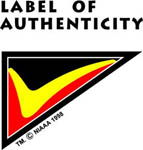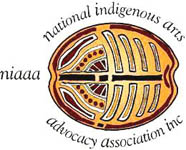|
Exploitation
of creative work can be a problem for any artist. For
Aboriginal and Torres Strait Islanders the problem is
often more complex as the symbols and motifs used in
their designs also hold cultural significance for a
particular group. Exploitation of the design impacts
not only on the artist but also on the group.
A
positive example of the use of copyright law by an Aboriginal
and Torres Strait Islander would be the use of Jimmy
Pike's artwork by Rowe Fabrics, Sydney for an interior
fabric. This was Pike's first licensing agreement in
home furnishings.
Jimmy
Pike,
…entered
into a series of business arrangements with Culley
and Wroth of Desert Designs. These would protect the
integrity of his art (and separate the paintings and
the production/marketing of limited edition prints)
but enable additional income to be derived from the
licensing of his designs and the strategic development
of the Desert Designs company. (O'Ferrall, 1995: 3)
Not
all Aboriginal and Torres Strait Islander people have
had such positive experiences.
In 1994
…
a case of theft of Aboriginal imagery occurred when
a businessman …had carpets made in Vietnam
with images stolen from Aboriginal paintings, and
falsely labelled them to give authenticity. The artists
took him to court and won. He was ordered to pay compensation
but went bankrupt.
(The Koori Mail, 1998: 15) this became known as The
carpet case.
Another significant case involving the infringement
of the copyright of an Aboriginal artist has been
resolved. The case, brought by the Sydney-based artist
Bronwyn Bancroft with the assistance of the Aboriginal
Arts Management Association, was listed for hearing
in the Federal Court on December 12, 1991.
The
clothing manufacturer Dolina Fashion Group Pty Ltd
supplied Grace Bros stores with an 'exclusive' dress
design for a major promotion through its network.
It was alleged that Dolina's stylists had requested
an Aboriginal look from the Japanese fabric
maker Sastani to present as the front line of their
fashion range.
The
fabric maker supplied a print in three colour ways,
which, it was alleged, was a direct copy of an original
artwork by Bancroft, Eternal Eclipse (1998),
which had been reproduced in Jennifer Isaac's book
Aboriginality: Contemporary Aboriginal Paintings
and Prints.
The
clothing manufacturer and retailers claimed that they
were innocent of the infringement and the fault lay
with the fabric maker who printed the design. The
case raised a number of interesting issues in copyright,
especially in relation to Aboriginal art.
Copyright
law, in its present form, functions best to protect
the individual artist from the unauthorised use of
his or her work. For artists to have their work pirated
represents a theft of their intellectual property
and a distortion of the intent of the artwork. Although,
in Bancroft's case, it may be difficult to prove who
was directly responsible for appropriating the image,
the design used by Dolina is a copy of Bancroft's
painting. The artist has suffered the shock and embarrassment
of seeing her original artwork trivialised. Bancroft
also has an established reputation as a fashion designer
of original garments, at a different level of the
fashion market from Dolina's styles for major retail
outlets. (Cochrane Simons, 1991)
|
The
Label of Authenticity
Bronwyn Bancroft's case is one of the cases that
motivated the development of the Label of Authenticity.
The National Indigenous Arts Advocacy Association
(NIAAA)
…through
funding from the Australia Council and ATSIC,
are in the process of developing a national
system of labelling that will distinguish art
and cultural products from the fake products.
As a certified trade mark the Label of Authenticity
will be attached to a product or used in relation
to a service originating from an Aboriginal
or Torres Strait Islander person. (NIAAA)
Why do we need a Label of Authenticity
For some time concern has been growing that
Aboriginal and Torres Strait Islander designs
and symbols have been incorrectly used, most
often without permission. Examples include artwork,
tourist souvenirs and carpets, to name a few.
The
primary responsibilities of the NIAAA as the
national peak Aboriginal and Torres Strait Islander
arts and cultural service include the continued
and increased recognition and protection of
the rights of Aboriginal and Torres Strait Islander
artists. NIAAA provides culturally appropriate
advice, information, referrals and support services
to indigenous artists and organisations. (NIAAA,
1999)
|

Label of Authenticity. Courtesy:
National Indigenous Arts Advocacy Association (NIAAA)
|

NIAAA logo. Courtesy: National
Indigenous Arts Advocacy Association (NIAAA)
|
Copyright
guidelines
The following questions developed by the NIAAA are suggested
as a guide to artists when they are asked about using
their work.
Copyright
detectives
To see just how extensive the problem of Aboriginal
art exploitation is, you can explore a CD-ROM, The
House of Aboriginality. The aim of the CD-ROM is
to get people to look at Aboriginal designs more closely,
and ask are they authentic or imitations?
The
CD-ROM features:
- an
image bank
- a
media file of news clippings
- Federal
Court judgements
- video
clips of Aboriginal artists.
(The Koori Mail, 1998: 3)
House
of Aboriginality CD-ROM (Mac and PC) A$55.00 (plus
$7.95 postage and handling within Australia). The House
of Aboriginality project team has also produced a Copyright
Detective's Kit. For A$75.00 (plus $7.95 postage and
handling within Australia) you will receive The House
of Aboriginality CD-ROM, 60 page full colour Copyrites
national touring exhibition catalogue, and official
House of Aboriginality Training Manual. Ideal
educational aid for all levels, from primary to tertiary,
leading students into the world of Aboriginal art via
the issues of copyright infringement and cultural integrity.
CD-ROM and Copyright Detective's Kit available from:
http://www.mq.edu.au/house_of_aboriginality/cdrom.htm
More
on ownership and copyright
For further information on ownership and copyright check:
Video
Copyrites, an SBS documentary on the issue of
copyright and Aboriginal motifs. Product code: SBCOP.
Available for $80.00 from Marcom Projects. Phone (07)
3801 5600 Fax (07) 3801 5622. Email: marcom@marcom.com.au
Articles
Adams, Phillip, Shame
of the White Man
Sugden,
P. (2001) Ownership: Style and the Law, Textile Fibre
Forum, No 62, p. 49.
Sugden, P. (2001) Plagiarism techniques and processes,
Textile Fibre Forum, No 61.
Sugden, P. (1996) Trade marks and textiles, What's in
a mark?, Textile Fibre Forum, No 47.
To
find out more about Textile Fibre Forum visit: www.ggcreations.com.au/tafta/.
|